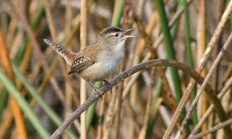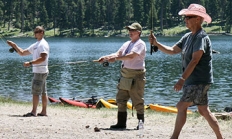Search myodfw.com
As their common name implies, these lizards are found in sagebrush habitats, but also occur in chaparral, juniper woodlands, and coniferous forests. They require well-illuminated open ground near cover and are primarily ground dwellers. They eat a variety of small invertebrates, including crickets, beetles, flies, ants, wasps, bees, mites, ticks, and spiders. Also called the Northern sagebrush lizard, it is an Oregon Conservation Strategy Species in the Columbia Plateau ecoregion. Photo by ©Keith Kohl, ODFW

The Western fence lizard occupies a wide range of habitats, from desert canyons and grasslands to coniferous forests. It requires vertical structure in its habitat, such as rock piles or logs. It is absent from dense, humid forests and flat desert valleys. This lizard is insectivorous, and feeds on crickets, grasshoppers, beetles, ants , wasps, leafhoppers, and aphids. Some spiders are taken as well. Photo from ODFW

The side-blotched lizard is found in sagebrush, juniper, and shadscale habitats. It is often found on sandy bottoms of washes or canyons, especially in the presence of scattered rocks. This small lizard feeds mostly on smaller invertebrates such as spiders, mites, ticks, sowbugs, beetles, flies, ants, and small grasshoppers. Photo by J. Maughn, Flickr
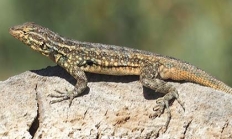
The Western skink is found in moist places such as under rocks or logs in a variety of habitats from grassland and chaparral to desert scrub, juniper woodlands, and coniferous woodlands and forests. Rocky areas with some moisture, such as riparian zones, are favored. This skink feeds on a wide variety of invertebrates, including beetles, grasshoppers, moths, flies, spiders, and earthworms. Photo by Simon Wray, ODFW
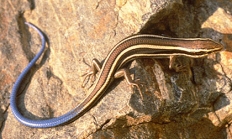
The Western whiptail is found in eastern Oregon deserts and semi-arid shrublands. It is most common in flat, sandy areas and along dry washes. These lizards are primarily insectivorous. In a food habits study in southeastern Oregon, they ate caterpillars, crickets, grasshoppers, and beetles. They also eat spiders, scorpions, and other lizards. Photo by Keith Kohl, ODFW

The plateau striped whiptail is a medium-sized, all-female species. Reproduction is by parthenogenesis - unfertilized eggs hatch into clones of the mother. In Oregon, this lizard only lives in Cove Palisades State Park. Photo by J. N. Stuart, Flickr

Oregon has 15 native snake species, from the beautifully colored California Mountain kingsnake to the rubber boa, a constrictor. Interestingly, the sharptail snake appears to specialize in feeding on slugs. And did you know that of our native snakes, only the Western rattlesnake has poisonous venom that's dangerous to humans? ODFW has a fun fact sheet for kids of any age, and a more in-depth brochure, Living with Snakes.

The rubber boa occurs in a variety of habitats, from desert scrub, foothill woodlands, and grasslands through deciduous and coniferous forests. In the Coast Range, it is found commonly in forest clearings that contain rotting stumps and logs. It is absent from the immediate vicinity of the coast north of Coos Bay. Rubber boas are constrictors and eat small mammals, especially young mice and shrews. Photo by Simon Wray, ODFW
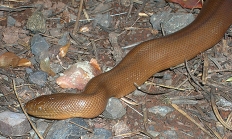
The racer is found in a variety of open habitats, including sagebrush flats, juniper woodlands, chaparral, and meadows. It avoids dense forests, high mountains, and very dry areas, and seeks cover under rocks, logs, or dense shrubs This species feeds on lizards, smaller snakes, frogs, toads, small mammals, birds and their eggs, and some insects. Young racers eat crickets, grasshoppers, and other insects. Photo by Simon Wray, ODFW
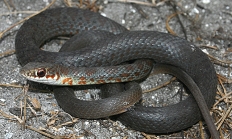
The sharptail snake is found in moist areas in coniferous forest, deciduous woodlands, chaparral, and grasslands. It frequents open grassy areas at forest edges and usually occurs under the cover of logs, rocks, fallen branches, or talus. Sharptail snakes appears to specialize in feeding on slugs. Photo by Calypso Orchid, Flickr

The ringneck snake requires moist micro-habitats such as downed logs, rocks, or stumps. It is found in a variety of vegetation types, but is most closely associated with pine-oak woodlands and moist canyon bottoms. It also can be abundant in Willamette Valley grasslands. These snakes feed mainly on small lizards, snakes and salamanders and also slugs, earthworms, frogs, and insects. Photo by Simon Wray, ODFW
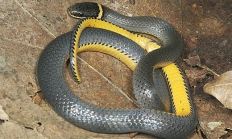
In the Pacific Northwest, the night snake frequents arid desert scrub habitats near rocky outcrops or rimrock. It takes refuge in talus slopes or rocky crevices during the day. Night snakes tend to feed on cold-blooded prey, especially lizards and their eggs, frogs, toads, salamanders, large insects, and small snakes. These snakes are primarily nocturnal, and are more active on relatively cool nights of early summer. Photo by Ken-ichi Ueda, Flickr

This snake is most common in thick vegetation along water bodies, but ranges into farmland, chaparral, and deciduous and mixed coniferous woodlands in the Rogue and Umpqua river valleys of southwestern Oregon. Common kingsnakes usually feed on other snakes, but have been known to take small turtles, birds and their eggs, frogs, lizards, reptile eggs, and some small mammals. Photo by Alan Schmierer, Flickr
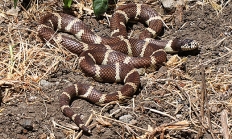
This species is found in pine forests, oak woodlands, and in chaparral of southwestern Oregon valleys. It is usually found in, under, or near rotting logs in open wooded areas near streams. The California mountain kingsnake preys upon snakes, lizards, birds and their eggs, and some small mammals. It is an Oregon Conservation Strategy Species in these ecoregions: Coast Range, Columbia Plateau, East Cascades, Klamath Mountains, and West Cascades. Photo by William Grenfell, Flickr

In the Northwest, this snake is found in grasslands, sagebrush flats, rocky stream courses, and canyon bottoms. Elsewhere it also frequents juniper and pine-oak woodlands. In southwestern Oregon, it is found in dry bushy areas close to rocks. Young striped whipsnakes feed primarily on lizards and insects. Adults also take snakes, small mammals, young birds, and insects. Photo by Bryn Hamilton, Flickr

The gopher snake occurs in a wide variety of habitats, from deserts and grasslands to woodlands and open forests. It frequents agricultural regions, especially where there is brushy cover such as fence rows. Diet varies according to size, with young eating insects, lizards, rodents, and birds and their eggs. Adults can take larger prey, occasionally as large as rabbits. Photo by Simon Wray, ODFW
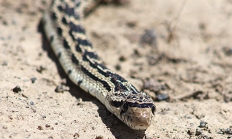
This moderately small wren maintains the frenetic energy that is so obviously typical of this family of birds. It is a summer inhabitant in many parts of Oregon, generally in open woodlands, thickets, and occasionally in residential gardens. The House wren occurs over the widest latitudinal range of any New World passerine. The House wren nests in a wide variety of native and human-influenced habitats. Nest sites are primarily located within preformed cavities in snags. It is a very uncommon to common transient and summer resident in semi-open woodland habitats throughout the state. In southwest Oregon, it is most common

This small, rich-brown wren is only slightly larger than a quarter, and has a tail quite short for a wren. A quiet observer in the forest will see these birds hop in and out and all over logs, snags, shrubs, twigs, and limbs on the forest floor. It has been said that the song of this bird is larger than the bird itself. The Winter wren breed from Coos County southward and in eastern Oregon in the Blue and Steens mountains. It retreats from high altitudes in winter where snow pack is heavy. Migration probably occurs throughout the state, but

This pugnacious little wren, formerly known as the Long-billed marsh wren, inhabits cattail, bulrush, and other marsh plants. As the only Oregon species of wren that nests over water, it is easy to identify when seen, but sexes are difficult to differentiate in the absence of song due to similar coloration. This species has long been of interest to behavioral and evolutionary ecologists due to its polygyneous mating system, widespread construction of dummy nests, and the male's complex singing behavior. The Marsh wren nests statewide in appropriate wetland habitats. It is particularly common during breeding season around Malheur National Wildlife
